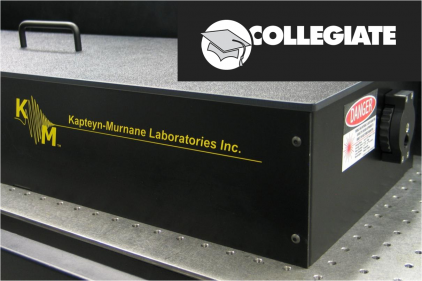for full specifications or with questions
Bringing ultrafast back to basics
The Collegiate is a wavelength-tunable ultrafast oscillator kit designed to bridge the gap between theoretical knowledge and hands-on experimentation for students and researchers. Originally introduced by KMLabs in 1994 as the first commercial Ti:sapphire laser capable of generating sub-12 femtosecond pulses, it has since been redesigned for greater accessibility and ease of use. The system offers practical experience with a real ultrafast oscillator, supporting a wide range of experiments in ultrafast optics and spectroscopy. With manual control over key parameters such as center wavelength, pulse duration, and mode-locking initiation, users gain a deeper understanding of the laser’s operating principles. These features make the Collegiate an ideal tool for educational laboratories and instructional settings.

Support Documentation |
| KMLabs Collegiate Datasheet |
Collegiate Specifications
| Center Wavelength | ~ 800 nm |
| Tunable Wavelength Range | ~ 750-850 nm |
| Repetition Rate | ~ 93 MHz |
| Maximum Mode-locked Power | > 500mW at 800nm |
Features
In educational settings, Collegiate offers a high performance ultrafast laser system at an appealing price point. The components are easy to access and provide a foundation for understanding the optical layout and laser operation. Perfect for advanced undergraduate or graduate level instruction.
Offered in multiple tiers, Collegiate is designed to accommodate a wide range of budgets and instructional needs. Whether you're an early-career educator or working within tight departmental funding, each tier offers reliable performance and essential functionality for teaching and demonstrations.
- The base-Collegiate provides a cost-effective solution without compromising on core features,
- The standard-Collegiate includes a dust-proof enclosure and basic diagnostics such as a spectrometer and fast photodiode ideal for demonstrating the oscillator's output.
- The premium-Collegiate includes enhanced mounting and full diagnostics package.
For ultrafast oscillators with custom needs, spare yourself the pain of starting from scratch. Instead, start with the Collegiate Ti:sapphire kit with its complete offering of compatible and tested components, and then modify as needed to meet your specialized requirements.
Applications
- Undergraduate advanced optics labs
- Frequency conversion into the UV and mid-IR
- Spectroscopy
- THz Generation




